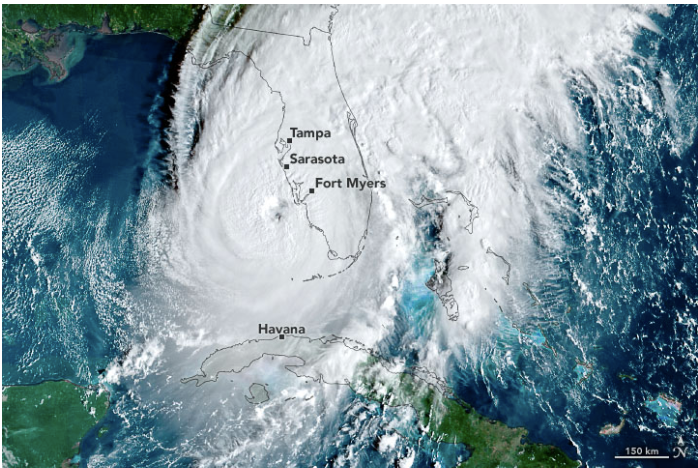Hurricane Ian
October 21, 2022
As Hurricane Ian ripped through parts of Florida, the death toll rose to over 100 people. Hurricane Ian started as a tropical storm somewhere in the middle Carribian Sea. Ian made landfall as a hurricane 3 times. When Ian first made landfall in the U.S, it hit the shore of Cayo Casto moving at 150 mph. The hurricane’s maximum sustained wind was 155 mph. This made it officially a category 4 hurricane and 2mph short of becoming a category 5. It made its final stand in South Carolina on September 30th. On top of its crazy wind speeds, Hurricane Ian also had a storm surge of 12-18 feet and a staggering 12.8 inches of rainfall, which is almost four times the average amount of rainfall for September in Orlando.
One of the beaches that were most greatly impacted by Ian was Fort Myers beach. Fort Myers Beach is a barrier island that is located between the Gulf and the city of Fort Myers and has a population of 5,400. The island that used to be a paradise for retirees is now covered in crushed beach houses, debris, and broken storefronts. “Steve Duello, 67, a retired grocery store executive from St. Louis, said he was devastated on Tuesday to see the damage to his Fort Myers Beach home for the first time since the hurricane hit,” states reuters.com’s article called “Florida beachfront paradise shattered by Hurricane Ian.” On top of Fort Myers beach, there were many other people impacted by the hurricane. Over 6,000 flights were cancelled between Florida and South Carolina. There were also 2.5 million evacuation orders put in place and around 3.4 million power outages. Even people who weren’t hit by Hurricane Ian still had the impacts of it.
Hurricane Ian significantly affected the inhabitants of the entire state of Florida, leaving cities in Orlando submerged in feet of water. For individuals living particularly close to the water, boats were pushed ashore and rammed into residential homes. This caused even more destruction for civilians. To put into retrospect how catastrophic and severe the storm was, the Florida National Guard was activated and sent out to search for stranded civilians in the flooded neighbourhoods of Orlando. A large section of the Sanibel Causeway was demolished and unfortunately lost. This causeway connects Sanibel Island with mainland Florida. As a result of the damage, access to the island community was cut off. The Florida Department of Transportation has constructed and situated a temporary lane for emergency vehicles to cross over to the island.

Unfortunately, the storm also took a toll on livestock and agriculture on Sanibel Island. Many programs are set up by the American Farm Bureau Federation (AFBF) to help farmers and ranchers recover from such catastrophic damages. Significant amounts of cattle, citrus, and speciality crops are located in areas in Southwest Florida where the damage was fatal. It is too soon for many farmers and ranchers to assess the full damage done to trees and vines, however, livestock owners are able to shelter, identify, and account for all cattle in a timely manner. In Myakka City, Florida, the Dakin Dairy Farm was almost fully torn down and 250 of their 2,400 milk cows died. Unfortunately, the death rate appears to keep increasing. This impacts the vast majority of milk drinkers in Manatee County as a large amount of their milk was being supplied by the family’s dairy farm. Repairs will take a while, but hopefully, all individuals are able to get back on their feet with the help of neighbours and federal programs.






















